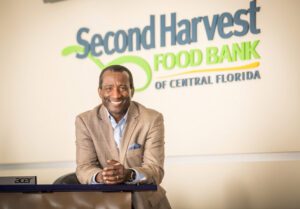Poverty isn’t a number in a bank account. It’s not an area code, or even a statistic. I define poverty as not having the financial independence to make critical decisions in one’s daily life. And unfortunately, we’re seeing this reach into the pockets of more and more people.
Lingering inflation means that many households still struggle to make ends meet. Food prices – especially the cost of eggs, produce and chicken – continue to rise as the cost of gas ticks upward again, too. In a state where the availability of affordable housing has been limited for years, families are finding it harder to cover rent, let alone re-starting after an active hurricane season wreaked havoc across the area.
 Those factors are among the reasons why food distribution at Second Harvest Food Bank of Central Florida has returned to the level we first saw at the height of the pandemic: 300,000 meals per day – up from 150,000 meals a day in early March 2020.
Those factors are among the reasons why food distribution at Second Harvest Food Bank of Central Florida has returned to the level we first saw at the height of the pandemic: 300,000 meals per day – up from 150,000 meals a day in early March 2020.
With more and more households having little or no savings to cover an emergency, expenses as small as $50 or $100 can be the difference between “having enough to get by” or falling into debt. And although the job market is strong, many low-wage jobs don’t provide workers with enough income to pay rising bills – meaning that working households now comprise an overwhelming majority of those who depend on our expansive network of community feeding partners.
We’re continuing to scale our services to meet the need in Central Florida. Second Harvest has increased the number of local organizations – totaling more than 600 – that are committed to feeding hope across Orange, Osceola, Lake, Seminole, Volusia, Brevard, and now, Marion counties, with us.
But simply meeting the need for food assistance today isn’t enough: We need to develop sustainable infrastructure and funding to keep our current distribution viable for weeks, months and even years to come – while working towards long-term progress.
For those in crisis, hunger is just one of many symptoms of poverty. Families may struggle to access healthcare or pay for necessary medications … to cover the cost of a car repair, an elevated electric bill or daycare for their children.
To tackle a multifaceted problem, we need a multifaceted solution – and the only way to achieve that is by partnering with organizations and leaders across the community. Second Harvest is preparing to launch new programs this year with the intent of serving the real needs of local families. But we also want to be sure our programs are meeting hungry neighbors where they are and in the right way.
Ending hunger starts with talking to – and working alongside – families and communities who are living with food insecurity. We want to listen to and learn about their challenges, needs and goals … and give them the tools and support they need to take action.
Our goal is not only to feed the hungry, but to feed success and change. Initiatives that “shorten the line,” like Second Harvest’s Culinary Training Program – a tuition-free curriculum designed to help low-income adults build careers in the food service industry – are crucial to that effort. Moving forward, we hope to build on that success with partnerships designed to expand career training options, improve nutrition education, and nourish achievement in schools and youth centers.
The fight against hunger and poverty in Central Florida isn’t one we can win alone – and if you want to get involved, there are countless ways to help. Volunteer at one of our facilities or with a partner organization; make a monthly pledge to contribute financially; and/or organize a “virtual food drive” in your neighborhood or workplace. To learn more about feeding hope, or if you need help finding a feeding partner near you, visit our website www.FeedHopeNow.org.
Derrick Chubbs is president and CEO at Second Harvest Food Bank of Central Florida.


